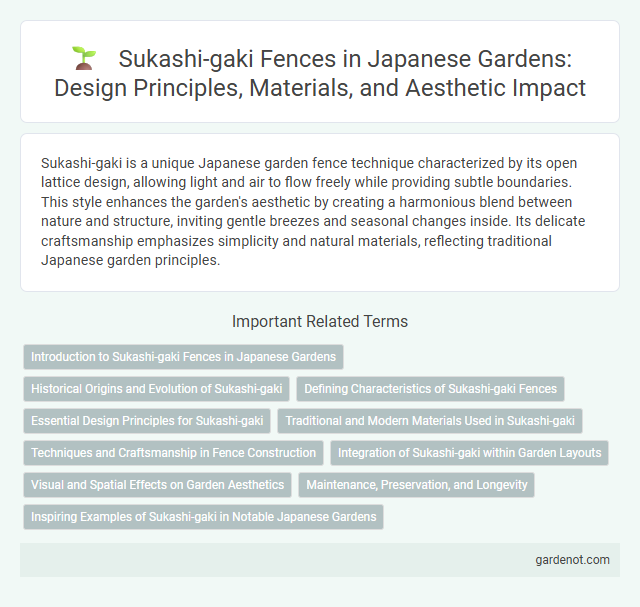Sukashi-gaki is a unique Japanese garden fence technique characterized by its open lattice design, allowing light and air to flow freely while providing subtle boundaries. This style enhances the garden's aesthetic by creating a harmonious blend between nature and structure, inviting gentle breezes and seasonal changes inside. Its delicate craftsmanship emphasizes simplicity and natural materials, reflecting traditional Japanese garden principles.
Introduction to Sukashi-gaki Fences in Japanese Gardens
Sukashi-gaki fences, characterized by their openwork design, play a vital role in Japanese garden aesthetics by blending function with artistry. Crafted typically from bamboo or wood, these fences create subtle visual barriers that enhance garden depth without obstructing views. Their intricate lattice patterns allow natural light and air to flow freely, contributing to the garden's serene and harmonious atmosphere.
Historical Origins and Evolution of Sukashi-gaki
Sukashi-gaki, a traditional Japanese woodworking technique, originated during the Muromachi period (1336-1573) and was primarily used in temple architecture and garden gates. This technique involves intricate openwork patterns that symbolize nature and spirituality, evolving over centuries to balance aesthetic beauty with structural functionality in Japanese gardens. Its historical evolution reflects the cultural significance of blending art with craftsmanship, enhancing the serene ambiance of gardens across Japan.
Defining Characteristics of Sukashi-gaki Fences
Sukashi-gaki fences feature an openwork design with vertical and horizontal wooden slats arranged to create geometric patterns that allow light and air to pass through, enhancing visual transparency and aesthetic appeal. These fences serve both functional and decorative purposes, blending seamlessly into traditional Japanese gardens by providing subtle boundaries without obstructing views. Crafted from natural materials such as cedar or cypress, Sukashi-gaki exemplify the harmonious balance between craftsmanship and nature fundamental to Japanese garden design.
Essential Design Principles for Sukashi-gaki
Sukashi-gaki, or latticed fences, embody essential design principles such as harmony, transparency, and natural integration, allowing glimpses of the garden while maintaining structure. Crafted from bamboo or wood, their spacing and pattern reflect balanced proportions that complement surrounding flora and stone elements. These fences enhance the garden's aesthetic flow, guiding viewers' sightlines subtly without obstructing the serene landscape.
Traditional and Modern Materials Used in Sukashi-gaki
Sukashi-gaki in Japanese gardens traditionally employs bamboo and cedar wood, known for their durability and natural aesthetics, creating intricate lattice patterns that filter light and air. Modern adaptations incorporate metals such as stainless steel and aluminum, offering enhanced weather resistance and minimalist design appeal while maintaining the delicate, openwork style characteristic of Sukashi-gaki. Combining traditional organic materials with contemporary metals enables garden designers to balance cultural heritage and innovation in landscape architecture.
Techniques and Craftsmanship in Fence Construction
Sukashi-gaki fences in Japanese gardens embody meticulous craftsmanship, utilizing intricate wood carving and precise joinery to create openwork patterns that blend aesthetics with functionality. Artisans employ traditional techniques such as mortise and tenon joints without nails, ensuring structural integrity while allowing natural weathering to enhance the wood's texture. The deliberate spacing and design of the Sukashi-gaki fence facilitate harmony between enclosure and openness, reflecting the garden's balance between nature and human artistry.
Integration of Sukashi-gaki within Garden Layouts
Sukashi-gaki, a traditional Japanese see-through fence, enhances garden layouts by creating subtle boundaries that maintain visual flow and openness. Its intricate openwork patterns blend seamlessly with natural surroundings, allowing light and air to pass while defining spaces without disrupting the harmonious balance. This integration supports the overall aesthetic of Japanese gardens, emphasizing simplicity, transparency, and connection between different garden elements.
Visual and Spatial Effects on Garden Aesthetics
Sukashi-gaki, a traditional Japanese garden fence style, enhances visual depth and spatial layering by incorporating openwork patterns that allow glimpses of the garden beyond, creating a harmonious interplay between enclosure and openness. Its intricate lattice design softens boundary lines while fostering a sense of continuity with natural surroundings, amplifying the garden's aesthetic balance. This technique emphasizes seasonal changes and the garden's textures by framing views without obstructing sightlines, enriching the overall sensory experience.
Maintenance, Preservation, and Longevity
Sukashi-gaki, a traditional Japanese garden fence characterized by its open lattice design, requires regular maintenance to prevent weathering and mold growth, ensuring its durability. Preservation involves periodic reapplication of natural oils and careful replacement of damaged slats to maintain its aesthetic appeal and structural integrity. Proper upkeep extends the fence's longevity, allowing it to harmoniously complement garden landscapes for decades.
Inspiring Examples of Sukashi-gaki in Notable Japanese Gardens
Sukashi-gaki, a traditional Japanese fencing technique characterized by its open lattice design, exemplifies the balance between privacy and harmony with nature in garden architecture. Notable gardens such as Ryoan-ji in Kyoto showcase Sukashi-gaki's intricate patterns that frame scenic views while allowing light and air to flow freely, enhancing the meditative atmosphere. This fencing style not only serves functional purposes but also acts as an artistic statement, reflecting the wabi-sabi aesthetic central to Japanese garden design.
Sukashi-gaki Infographic

 gardenot.com
gardenot.com